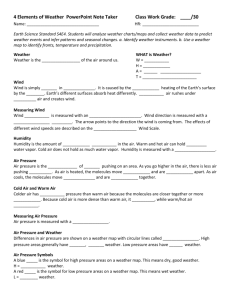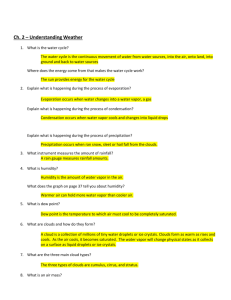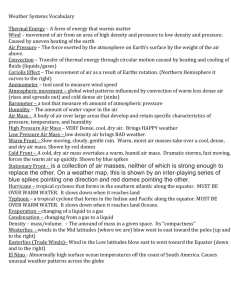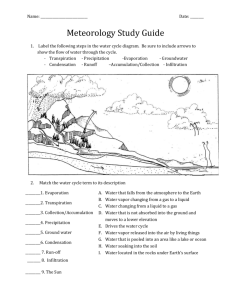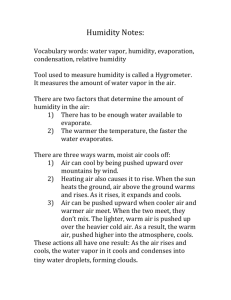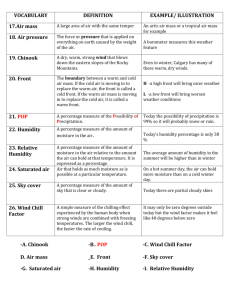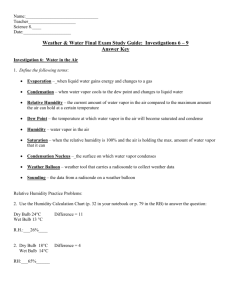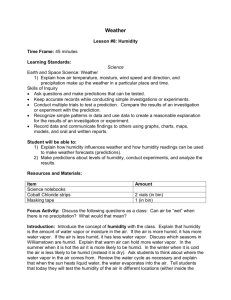File
advertisement
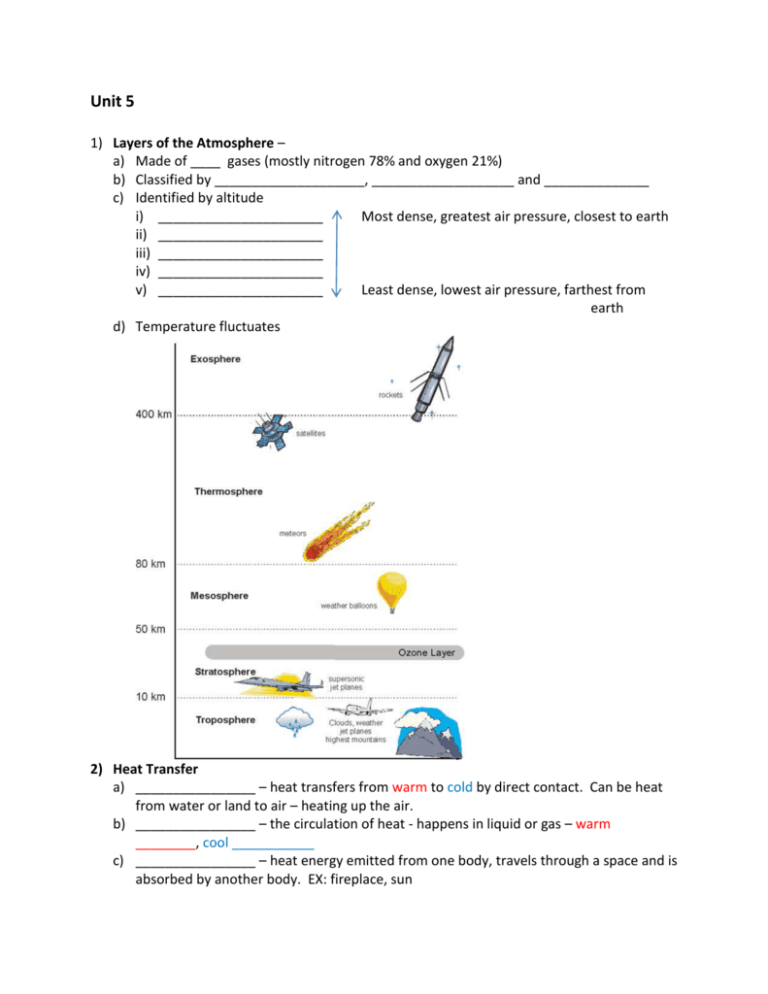
Unit 5 1) Layers of the Atmosphere – a) Made of ____ gases (mostly nitrogen 78% and oxygen 21%) b) Classified by ____________________, ___________________ and ______________ c) Identified by altitude i) ______________________ Most dense, greatest air pressure, closest to earth ii) ______________________ iii) ______________________ iv) ______________________ v) ______________________ Least dense, lowest air pressure, farthest from earth d) Temperature fluctuates 2) Heat Transfer a) ________________ – heat transfers from warm to cold by direct contact. Can be heat from water or land to air – heating up the air. b) ________________ – the circulation of heat - happens in liquid or gas – warm ________, cool ___________ c) ________________ – heat energy emitted from one body, travels through a space and is absorbed by another body. EX: fireplace, sun 3) Daily Weather a) Water has three stages: ___________(ice), _________ (water), and _________ (water vapor) b) Heat changes these stages. i) Heat added – molecules move ____________! ii) Heat removed – molecules move _____________ c) Factors of Weather i) Temperature – Earth heats _____________ (warmer at the equator – cooler at the poles) ii) Humidity – _____________________________________. (1) ____________ humidity – lots of water vapor! Air is _______________ (2) _________ humidity – low water vapor! _______________ air (3) ________________humidity – how much water vapor is in the air in relation to how much water vapor the air can hold at that temperature. As the temperature goes up, the relative humidity goes down. iii) Wind – ____________________________ (1) Heat affects _______________________________ (2) Heat = more energy in air (just like with water). Heated air moves and __________, becomes ________ dense and __________ (3) Air moves in groups called _____________________ cells iv) Air Pressure – CAUSES WIND! (1) ________ Pressure (a) Warm, humid air full of water vapor (b) Rises (c) Brings __________ weather conditions (2) __________ Pressure (a) Cold, dry air (b) Falls/sinks (c) Brings ___________________ weather (3) Air Pressure Gradient – change in air pressure between two air masses. (a) Steeper gradient = __________________ wind 4) Coriolis Effect a) As air is circulating in convection cells, the earth is rotating. This causes wind to veer to the east or west. b) Air moving from the equator to the poles _________________ and veers to the east. c) Air moving from the poles to the equator _________________ and veers to the west. 5) Friction a) Friction between air molecules and Earth’s surface __________________ 6) __________________ – large section of air with same temperature, pressure and humidity a) Polar – ______________ b) ___________ – WARM c) Continental –__________ d) _______________ – HUMID e) WARM air masses – travel toward the ____________ i) Maritime Tropical - low pressure, low density, bring humid/ muggy weather ii) Continental Tropical – greater pressure, greater density, bring warm, dry weather f) COLD air masses – travel toward the _______________ i) Maritime Polar – low pressure, low density, cold and humid weather ii) Continental Polar - greater pressure, greater density, cold and dry weather iii) ________________ - greater pressure, greater density, extremely cold and dry 7) __________ – when two air masses meet at their boundary a) Warm front - __________________ air presses forward – pushes cold air back i) Bring ____________ weather b) Cold front – _______________ air pushes forward - pushes warm air up and back i) Brings ______________ c) Stationary front – at a ______________. i) Brings gray skies, rain or snow lasting several days d) ______________ front – warm air gets stuck between two cold fronts i) Brings light to heavy precipitation that may last several days 8) Meteorologist – _____________________________________ a) Uses ________, ________________ and ____________ to measure air pressure, temperature, humidity levels, etc. b) Barometer – _______________________ i) High pressure – mercury goes __________ ii) Low pressure – mercury goes _________ c) Hygrometer – measures ___________________ 9) ________________– average weather conditions of an area long term (temperature and precipitation levels) a) b) c) d) _________ – Cold and dry ____________ – Moderate – seasons ____________ – Hot, humid with lots of rainfall Changes in climate are caused by: i) ________________ – distance from the equator. The closer to the equator, the higher the temperature ii) _________________________ AND proximity to a body of water– often windy by the sea. (1) Air is warmer above land than above water – the difference in air temperature causes wind. (2) Ocean winds carry moisture, bring rain and fog (3) Ocean currents bringing in warm water or cold water – which then brings in warm or cold air as well iii) ______________________ – block wind and can affect precipitation (1) Windward – wind facing side (2) Leeward – down wind side (3) When moisture hits the windward side of the mountain – rain or snow falls because the air is forced to rise and cool – this releasing moisture. (4) By the time the wind reaches the other side of the mountain, it is mostly dry and cool. 10) Global Warming – a trend showing that the average temperature of Earth’s atmosphere is increasing. a) _____________________ – Energy from the sun is absorbed by Earth’s surface converted to head and released into the atmosphere b) Clouds and gases trap rising heat and redirect it back to the Earth’s surface – heating up the earth. c) Greenhouse gases – i) _____________________ - water vapor, nitrous oxide (N2O), carbon dioxide (CO2), methane, and the ozone gases. ii) _____________ – chlorofluorocarbons (CFCs) and carbon dioxide (CO2). (CO2 is both natural and manmade.) (1) Destroy the Ozone
